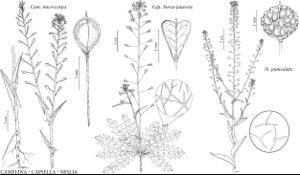Camelina
Stirp. Austr. Fasc. 1: 17. 1762.
| Taxon | Illustrator ⠉ | |
|---|---|---|
 | Camelina microcarpa Capsella bursa-pastoris Neslia paniculata | Yevonn Wilson-Ramsey Yevonn Wilson-Ramsey Yevonn Wilson-Ramsey |
Annuals or biennials; not scapose; pubescent, glabrescent, or glabrous, trichomes simple or short-stalked, with forked to substellate or subdendritic (smaller) ones. Stems erect, unbranched basally, branched distally, (basally hirsute with simple trichomes or sparsely pubescent with branched ones). Leaves basal and cauline; petiolate or subsessile; basal (often withered by flowering), rosulate or not, petiolate, blade margins entire or toothed or, rarely, lobed; cauline blade (base auriculate or sagittate), margins entire, dentate to lobed, or denticulate. Racemes (corymbose, several-flowered), considerably elongated in fruit, (rachis straight, rarely strongly flexuous). Fruiting pedicels ascending to divaricate, slender. Flowers: sepals erect to ascending, oblong or ovate; petals usually yellow, rarely white, oblanceolate [spatulate], (longer than sepals), claw and blade somewhat differentiated, (apex obtuse); stamens in 3 pairs of unequal length; filaments not dilated basally; anthers ovate or oblong, (apex obtuse); nectar glands (4), lateral, 1 on each side of lateral stamen. Fruits silicles or, rarely, siliques, dehiscent, shortly stipitate, pyriform, obovoid, or depressed-globose [linear], keeled or not, slightly latiseptate; valves each with prominent or obscure midvein, (leathery, smooth, margins of each flattened and connate, apex abruptly caudate and extending 1–2.5 mm onto, and appearing as part of, style), pubescent; replum concealed by connate margins of valves; septum complete; ovules 8–25 per ovary; stigma capitate. Seeds biseriate or, rarely, uniseriate, plump or slightly flattened, not winged or narrowly margined, oblong; seed-coat (minutely reticulate), copiously mucilaginous when wetted; cotyledons incumbent or, rarely, accumbent. x = 6, 7, 10, 13.
Distribution
Introduced; Europe, Asia, n Africa, also in South America, Australia
Discussion
Species 8 (4 in the flora).
Some authors have studied allelopathic and other effects of Camelina on the growth and production of flax, and the interested reader should consult I. A. Al-Shehbaz (1987) for leads. Some species, especially C. sativa, were cultivated for their fibers and seed oil by the Romans as early as 600 b.c., and remain in cultivation in some parts of eastern Europe and Russia.
Camelina alyssum and C. sativa may no longer be established in the United States.
Selected References
Lower Taxa
Key
| 1 | Fruits 3.5-7 mm, valves obscurely veined; seeds 0.8-1.5 mm; stems basally with simple trichomes (to 2.5-3.5 mm), these often mixed with branched ones | > 2 |
| 1 | Fruits 7-13 mm, valves prominently veined; seeds (1.5-)1.8-3 mm; stems basally glabrous or trichomes almost exclusively minute and branched, rarely trichomes simple | > 3 |
| 2 | Petals pale yellow, (2.5-)3-4(-6) mm; basal leaves withered by anthesis. | Camelina microcarpa |
| 2 | Petals white or creamy white, (5-)6-8(-9) mm; basal leaves persistent after anthesis. | Camelina rumelica |
| 3 | Fruits pyriform to broadly obovoid, 4-5(-6) mm wide, distinctly longer than wide; cauline leaf blade margins entire or denticulate. | Camelina sativa |
| 3 | Fruits depressed globose, (5.5-)6.5-8(-9) mm wide, nearly as long as wide or slightly longer; cauline leaf blade margins coarsely dentate to lobed. | Camelina alyssum |
"elongated" is not a number."thick" is not a number.